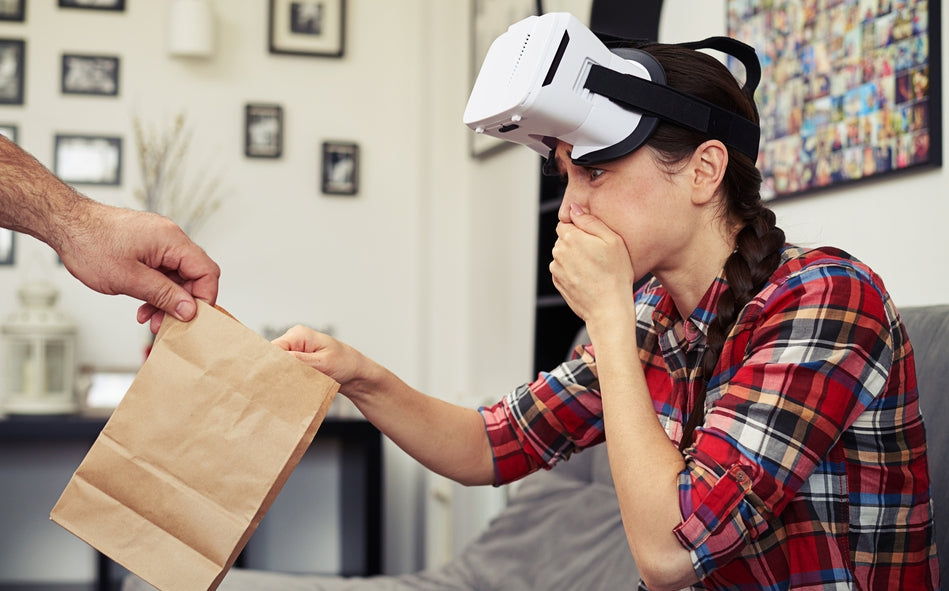Have you ever felt dizzy or nauseous after spending some time scrolling on your smartphone? Or perhaps you felt like the light coming out of your computer screen is hurting your eyes and giving you headaches?
These unpleasant sensations are often mistaken as just an eye strain or fatigue from prolonged screen use. However, these are actually symptoms of a more complex condition called cybersickness.
Seeing that our day to day tasks revolve mostly around digital screens, cybersickness has become a common issue among society. In this article we will provide you with the causes and symptoms of cybersickness, along with some tips on how to prevent it. These tips will help you avoid feeling sick from prolonged screen use and maintain good overall health. We will also look into if blue light glasses help with cybersickness.
What is the definition of cybersickness?
Cybersickness is a condition defined by a combination of symptoms which are similar to motion sickness. These symptoms are a result of prolonged digital screen use. Motion sickness feels very similar to cybersickness, however cybersickness occurs in the absence of physical motion.
People who develop cybersickness can experience disorientation, lightheadedness, and vertigo. These symptoms can last for hours and can negatively impact your sleep quality. Certain background images and screensavers have a higher chance of triggering cybersickness, especially when a background image is static while having content moving around on your screen.
Cybersickness works a lot like motion sickness as it is triggered by your senses sending conflicting signals to your brain. Orientation plays an important role as it gives you an indication of where you are, and how you’re moving in your space and in your environment.
So what are the main causes and how long does cybersickness last?
What causes cybersickness?
Cybersickness is caused by confusion and a mismatch in sensory communication. So when your senses communicate information to your brain which is contradictory, it makes you feel disorientated and results in undesirable physical symptoms.
Your interpretation of what you see through your visual system tells your brain what you are seeing through your eyes. For example, when your visual system tells your brain that you’re moving, but in reality you are stationary, you experience a sensory conflict and causes confusion. The same applies when you look at a flashing screen. Your visual system tells your brain that there’s a lot of movement. But at the same time your system tells your brain that all is steady and that you are not moving.
This kind of contradiction can make you feel lightheaded, cause dizziness and can also make you sick to your stomach. Cybersickness can last from just a couple of minutes, and even up to 24 hours in more severe cases. Let’s have a look at the symptoms of cybersickness.

What are the symptoms of cybersickness?
Just as motion sickness doesn’t affect everyone, the same goes for cybersickness. Symptoms vary from one person to another, but these usually involve nausea and lightheadedness. The main symptoms related to cybersickness fall in the below categories:
- Nausea
Nausea can be an early sign and symptom of cybersickness. If you’ve had a large meal, the nausea seems to get worse. You might feel sensitive to strong smells or a stuffy room with lack of ventilation. In severe cases, it can also lead to vomiting.
- Lightheadedness
Feeling dizzy and lightheaded is a common symptom of prolonged screen use. If you work on screens with moving illustrations or images, there’s a higher chance of developing cybersickness and dizziness. You might feel like the room is spinning which can leave you feeling disoriented. This makes it difficult to focus and concentrate on your tasks during your work.
- Headache & Migraines
Prolonged use of electronic devices can also cause headaches and migraines. Apart from the harmful light emitted from the screens, headaches can also result from bad postures. Staying in one position too long can result in neck and shoulder strain. Headaches can also be accompanied by other symptoms such as fatigue, flushing, sweating and lack of concentration.
- Digital Eye strain
Looking at digital screen devices can be strenuous on the eyes. This can cause fatigue, dryness, irritation, and also blurry vision.
Cybersickness remedies can help relieve these symptoms and improve your wellbeing. Let’s have a look at how to treat cybersickness and what kind of cybersickness cures are possible for you.
Cybersickness remedies and prevention
Ideally it’s best if you take preventive measures to avoid developing cybersickness in the first place. Following these tips can help you prevent developing undesirable symptoms:
- reducing the amount of digital screen time
- taking frequent breaks to rest your eyes
- getting up to stretch
- wearing cybersickness blue light blocking glasses
- ensuring a good posture for your back, head and neck
- avoiding using multiple screens at a time
- writing notes on paper instead of electronically
- avoiding flashy displays and illustrations
- avoiding eating heavy meals before prolonged screen time
- ensure good ventilation in your workspace
People who suffer from motion sickness are more likely to develop cybersickness if they engage in video games and VR. So, if you’re prone to motion sickness, it’s best to avoid complex video games and VR as you will most likely develop these undesirable symptoms.
Cybersickness, virtual reality, and augmented reality
VR is a kind of technology that replaces your view of the real world with an immersive, artificial environment, and blocks your view of the real world. Virtual reality games and apps have become more popular and are now widely commercially available through gaming platforms.
These kinds of games tend to trigger more intense cybersickness symptoms and can result in severe levels of nausea. People who are sensitive to motion sickness might not be able to use VR and play these games as their symptoms can worsen with duration.

Augmented reality is a different kind of technology that portrays a simulated environment onto the real world. So with AR, you can still see what’s in front of you. A popular game which has been trending is Pokémon Go which you could play on your phone or tablet and these kinds of AR games tend to cause more severe oculomotor strain.
Studies also show that emotional distress is associated with cybersickness and these kinds of games. Even if you don’t play VR or AR games, it’s highly likely that you spend a significant amount of hours looking at digital screens. Our jobs and leisure time are mostly spent using electronic devices and it’s difficult to avoid using them. At the same time, it’s important to take care of your health. So what can you do to prevent cybersickness while using digital devices? Cybersickness glasses or computer glasses have been found to be useful to prevent cybersickness symptoms.
Do blue light glasses help with cybersickness?
Scientifically proven blue light blocking glasses are known to help with cybersickness as they protect your eyes from the harmful blue light emitted from the screens of your smartphone, laptop, tablet and TV screen.
Blue light is high in energy and has a short wavelength which means that it can be harmful when you are exposed to it for a significant amount of time. It can cause several uncomfortable symptoms which are also present in cybersickness such as:
- Headaches & migraines
- Digital eye strain
- Blurry vision
- Sensitivity to light
- Having difficulty concentrating
- Sleep irregularity
Wearing blue light glasses is a good remedy and helps you to prevent cybersickness in the first place. That way you can make your work more sustainable as you are protecting your eyes and overall health. Have a look at our blue light glasses to help prevent cybersickness and ensure that you are using technology safely:
Daytime Blue Light Glasses
-
Screentime Computer Glasses & Daymax Glasses
The ScreenTime Computer Glasses and Daymax Glasses are ideal for an office environment or when you are working at home on your computer. These glasses are specifically designed to allow the good light to be absorbed by your eyes during the day. At the same time, they filter the harmful blue light that causes dry eyes, digital eye strain, headaches and migraines. For those who struggle with light sensitivity, the Daymax Glasses are a better fit for them as the yellow lens reduces symptoms of light sensitivity.

Night time Blue Light Glasses
-
Sundown Glasses & Nightfall Glasses
The SunDown Glasses and Nightfall range are specifically created and verified to block 100% of blue light. They should be worn during the evening hours to increase melatonin production and improve your sleep quality. The Nightfall Glasses also block green light which is the next colour on the visible spectrum to blue light. The best is to wear these glasses at least 2-3 hours before bedtime to ensure a good sleep at night.

How to treat cybersickness
As the saying goes, prevention is better than cure. The best way to avoid cybersickness is to wear scientifically proven blue light blocking glasses when looking at screens to reduce symptoms while working. Cybersickness glasses, also known as blue light glasses, can also be used to treat and reduce cybersickness symptoms as they protect your eyes from harmful blue light.
Additionally, if you start feeling cybersickness symptoms, you should step away from the screen you’re looking at and take a break. It’s important to show your brain visual cues that indicate that you’re not moving. So looking at something that is stationary and not moving will help you relieve the symptoms.
If your symptoms are more persistent and severe, you can relieve symptoms with over-the-counter medicine. It’s always important to seek medical advice prior to taking any medications. If your cybersickness symptoms are not severe and frequent, you probably won’t need to see a doctor. Should you be having more frequent or severe symptoms, it’s good to pay the doctor a visit to identify the cause of your symptoms and further treatment.
References:
- https://www.govexec.com/technology/2021/07/screentime-can-make-you-feel-sick-here-are-ways-manage-cybersickness/184061/
- https://www.healthline.com/health/cybersickness#What-is-cybersickness
- https://onlinelibrary.wiley.com/doi/10.1111/j.1600-079X.2006.00332.x





